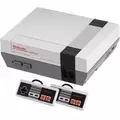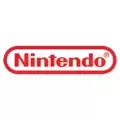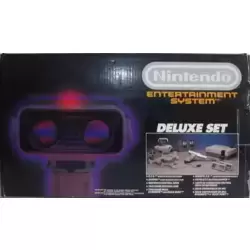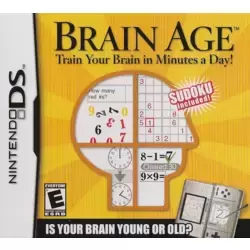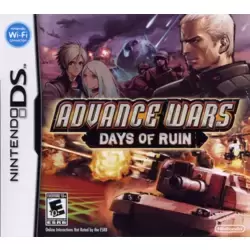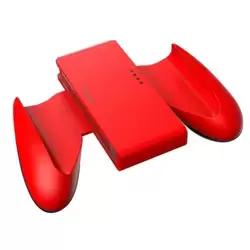




Nintendo's Famicom has experienced unprecedented success. In just a few years, it has swept up almost the entire video game market, marking the transition from the American era to the Japanese era. This is only the beginning of a hegemonic situation that will last throughout the late 1980s.
Ten years after the console's release, in 1993, a lot of water has flowed under the bridges. Yet, Nintendo's 8-bit console is not yet dead and constitutes the low-end of Japanese players. The Super Famicom has already been released, and although it is experiencing huge success, it is not as total as that of the Famicom.
To celebrate the ten years of its mythical console, Big N. releases a new version of its machine. Smaller, its design has been updated, which also allows to lower the production cost. For users, it offers what everyone has been waiting for a long time: a decent video output.
The first Famicom is connected to the antenna socket. So you have to find the channel on the TV, in short, it's really not practical. The newcomer brings a composite connection, via a classic RCA, but much more practical. The connector is of good enough quality for the image not to be too blurry. The connector is the same as the one on the Super Famicom.
Nintendo soberly names its console Family Computer, that is to say exactly like its illustrious big sister. To differentiate the two consoles, fans will call the newcomer Famicom AV, since it has the AV output.
Regarding the design, goodbye the purple and white of the original, the colors used here are those of the American and European versions: gray and red. The edges are less sharp, a little more rounded, and the look is rather successful, reminiscent of the design of the Super Famicom.
The controllers are no longer attached to the central unit, and the ports used are, once again, those of the NES. The controllers are a mix between the NES version and the Super Famicom controller. The ergonomics are very nice but we lose the microphone integrated into the controller 2. This is not really detrimental since the games that have used this feature can be counted on the fingers of one hand.
Compatibility is complete with the old model, both software and hardware. The DB-15 port is still present, allowing you to connect a few original controllers. The Disk System is of course also usable. For the power supply, it's a simple 9V.
You'll find it in the American version under the name NES 2, with the 72-pin connector of course (the Japanese version has a 60-pin connector). On the other hand, no reuse of the ZIF (Zero Insertion Force) cartridge port of the NES, we have the classic, which is ultimately much better.
In Europe, as always at this time, we won't see anything coming. The fact is that the NES is not in very good shape and is rather discounted, the behavior of European and Japanese players being radically different. The latter are players who are enormously interested in new releases without denying the past. It's not even considered as retro-gaming, but simply as gaming. A good game remains a good game, regardless of its age.
This also makes it possible to counter the many pirate consoles that many people buy because they are much more practical to connect than the first Famicom.
It is ultimately an excellent console, very practical. A nice updated version of a console that has radically changed the face of the video game world.
COLEKA estimate
View quotation
View quotation
- Rarity rank
- 100%2 member(s) have it
- Collection / Series
- Nintendo Entertainment System Stuff
- Release date
- 19931993
- Video game publisher
- Type of item
- Console Model
- ean
- 4902370501841
08/12/2022
 Collector action figures
Collector action figures Trading Cards
Trading Cards LEGO
LEGO Playmobil
Playmobil Video Games
Video Games Happy Meal McDonald's Toys
Happy Meal McDonald's Toys Other Toys
Other Toys Comics & Graphic Novels
Comics & Graphic Novels Stickers
Stickers DVD & BluRay
DVD & BluRay Manga
Manga Books
Books Board Games
Board Games Kinder Suprise
Kinder Suprise Diecast cars
Diecast cars Magazines
Magazines Other collections
Other collections